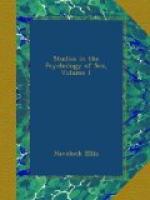to be attractive. When discomfort arises,
most women say that they feel this because ’it
looks as if they had no control over themselves.’
When they feel that there is no need for control,
they no longer feel fear, and the relaxor effect
has a wider field of operation, producing a general
rosiness, erection of spinal sexual organs, etc.
Such a blush would thus be a partial sexual equivalent,
and allow of the inhibition of other sexual effects,
through the warning it gives, and the fear aroused,
as well as being in itself a slight outlet of
relaxor energy. When the relationships of
the persons concerned allow freedom to the special
sexual stimuli, as in marriage, blushing does not occur
so often, and when it does it has not so often
the consequent of fear.”
There can be no doubt that the blush is sexually attractive. The blush is the expression of an impulse to concealment and flight, which tends automatically to arouse in the beholder the corresponding impulse of pursuit, so that the central situation of courtship is at once presented. Women are more or less conscious of this, as well as men, and this recognition is an added source of embarrassment when it cannot become a source of pleasure. The ancient use of rouge testifies to the beauty of the blush, and Darwin stated that, in Turkish slave-markets, the girls who readily blushed fetched the highest prices. To evoke a blush, even by producing embarrassment, is very commonly a cause of masculine gratification.
Savages, both men and women, blush even beneath a dusky skin (for the phenomenon of blushing among different races, see Waitz, Anthropologie der Naturvoelker, Bd. I, pp. 149-150), and it is possible that natural selection, as well as sexual selection, has been favorable to the development of the blush. It is scarcely an accident that, as has been often observed, criminals, or the antisocial element of the community—whether by the habits of their lives or by congenital abnormality—blush less easily than normal persons. Kroner (Das koerperliche Gefuehl, 1887, p. 130) remarks: “The origin of a specific connection between shame and blushing is the work of a social selection. It is certainly an immediate advantage for a man not to blush; indirectly, however, it is a disadvantage, because in other ways he will be known as shameless, and on that account, as a rule, he will be shut out from propagation. This social selection will be specially exercised on the female sex, and on this account, women blush to a greater extent, and more readily, than men.”
The importance of the blush, and the emotional confusion behind it, as the sanction of modesty is shown by the significant fact that, by lulling emotional confusion, it is possible to inhibit the sense of modesty. In other words, we are here in the presence of a fear—to a large extent a sex-fear—impelling to concealment, and dreading self-attention; this fear naturally disappears, even though its ostensible cause remains, when it becomes apparent that there is no reason for fear.




